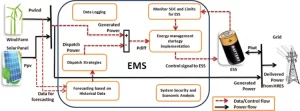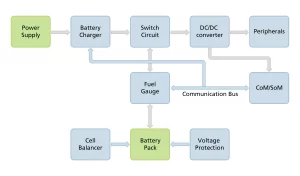Power and energy management are often interchangeable terms but encompass distinct concepts and functionalities. This comprehensive guide will explore the differences between power and energy management, exploring the roles of Energy Management Systems (EMS) and Battery Management Systems (BMS).
Part 1. What is an EMS system? (Energy Management System)

An EMS, or Energy Management System, is a sophisticated electronic system designed to monitor, control, and optimize energy use in various applications. It employs sensors and software algorithms to analyze energy consumption patterns, identify inefficiencies, and implement strategies to reduce energy waste. In the context of batteries, an EMS plays a crucial role in regulating the charging and discharging processes, ensuring optimal performance, prolonging battery life, and enhancing overall energy efficiency.
Part 2. What is a BMS system? (Battery Management System)

A BMS, or Battery Management System, is essential in battery-powered devices and electric vehicles. It oversees the battery’s health, performance, and safety by monitoring parameters such as voltage, current, temperature, and state of charge. Through active management, the BMS ensures balanced charging, prevents overcharging or over-discharging, and safeguards against potential hazards like thermal runaway. The BMS optimizes battery usage, extends its lifespan, and promotes reliable operation in diverse applications.
Part 3. Comparison of EMS and BMS components and functions
Energy Management System (EMS)
Energy Monitoring Devices:
Energy monitoring devices are hardware components that collect and measure energy consumption data from various sources within a building or facility. These devices, such as smart meters or sensors, track electricity, gas, water, or other utility usage. The primary function of energy monitoring devices is to provide real-time data on energy consumption, allowing users to identify areas of inefficiency and make informed decisions for energy optimization.
Data Acquisition System:
The data acquisition system in an EMS is responsible for collecting, processing, and storing energy data obtained from the monitoring devices. It typically consists of a central server or database where the energy data is stored and analyzed. The data acquisition system ensures that the energy consumption information is readily available for further analysis and decision-making.
Energy Analytics Software:
Energy analytics software is a crucial component of an EMS that processes and analyzes the collected energy data. This software utilizes algorithms and data models to identify energy consumption patterns, trends, and anomalies. Leveraging advanced analytics enables users to gain insights into energy usage patterns, identify areas of waste or excessive consumption, and develop strategies for energy optimization.
Control and Automation System:
The control and automation system within an EMS allows for the remote control and management of energy-consuming devices or systems. It may consist of programmable logic controllers (PLCs), building automation systems (BAS), or other intelligent controllers. This system allows users to implement automated energy-saving measures, such as scheduling equipment operations, adjusting setpoints, or activating energy conservation modes.
Battery Management System (BMS)
Battery Monitoring and Sensing:
A BMS includes sensors and monitoring devices that gather data about the battery’s voltage, current, temperature, and state of charge. These sensors provide real-time information on the battery’s health and performance, allowing the BMS to make informed decisions regarding charging, discharging, and overall battery management.
Battery Balancing and Equalization:
A BMS employs balancing and equalization techniques to maximize the efficiency and lifespan of battery cells. This involves redistributing the charge among individual battery cells to ensure they have uniform voltage levels. By balancing the cells, the BMS prevents overcharging or undercharging specific cells, which can degrade battery performance and reduce overall capacity.
Thermal Management:
Battery temperature plays a critical role in its performance and safety. A BMS includes thermal management features to monitor and control the battery pack’s temperature. This may involve cooling systems, such as fans or liquid cooling, to maintain the battery within optimal temperature ranges. Proper thermal management helps prevent overheating, damaging the battery, and compromising its safety.
State of Charge (SoC) Estimation:
The BMS utilizes algorithms and models to estimate the battery’s state of charge (SoC). SoC estimation is crucial for accurately determining the charge remaining in the battery and predicting its runtime. The BMS enables users to effectively plan and utilize the battery’s energy storage capabilities by providing an accurate SoC estimation.
Safety and Protection Mechanisms:
A BMS incorporates safety features to protect the battery from adverse conditions, such as overcharging, over-discharging, short-circuiting, or excessive temperature. It includes protective measures like current limiting, voltage monitoring, and fault detection algorithms to ensure the battery operates within safe limits and prevents potential hazards or damage.
Communication and Interface:
A BMS often includes communication interfaces, such as CAN (Controller Area Network) or RS485, to facilitate communication between the battery pack and external systems. This allows for seamless integration with other components within the more extensive system, enabling data exchange, remote monitoring, and battery operation control.
|
Component |
Energy Management System (EMS) |
Battery Management System (BMS) |
|
Energy Monitoring Devices |
Hardware components collecting energy consumption data |
Sensors monitoring battery parameters |
|
Data Acquisition System |
Collects, processes, and stores energy data |
Gathers real-time battery information |
|
Energy Analytics Software |
Analyzes energy data to identify patterns and trends |
Utilizes algorithms to estimate battery state and performance |
|
Control and Automation System |
Allows remote control and management of energy devices |
Balances charge among battery cells and controls temperature |
|
Battery Monitoring and Sensing |
Monitors battery voltage, current, temperature, and state |
/ |
|
Battery Balancing and Equalization |
Equalizes charge among battery cells |
/ |
|
Thermal Management |
Controls battery temperature to prevent overheating |
Utilizes cooling systems to maintain optimal temperature |
|
State of Charge Estimation |
Estimates battery’s state of charge for runtime prediction |
Estimates remaining charge for efficient usage |
|
Safety and Protection Mechanisms |
Includes protective measures against overcharging, overheating, etc. |
Ensures battery operates within safe limits |
|
Communication and Interface |
Facilitates communication with external systems |
Enables integration with larger system for monitoring/control |
Part 4. Conclusion
Power and energy management are distinct yet interconnected concepts that are vital in optimizing energy utilization and operational efficiency. Power management controls and regulates power distribution and consumption within a system. In contrast, energy management takes a broader perspective, considering the entire energy ecosystem. Energy Management Systems (EMS) provide organizations with comprehensive frameworks to monitor, analyze, and optimize energy usage. At the same time, Battery Management Systems (BMS) specialize in monitoring, controlling, and safeguarding the performance of rechargeable batteries.
Related Tags:
More Articles

Overview of Deep Cycle Lithium Battery
In this article, we explore the life, voltage, capacity, and charging considerations of deep cycle lithium batteries.
How Long do Lithium Batteries Last?
How long do lithium batteries last? we will explore the factors that influence the lifespan of lithium batteries and provide insights into their longevity.
How to Choose the Best LiFePO4 Battery?
Choose LiFePO4 batteries for superior performance, safety, and versatility in EVs, UPS, and backup power. This guide helps you make informed decisions.
Get 12v Lithium Car Battery As a Power Source for the Ride
Make the right choice for your vehicle's battery needs by installing a 12 volt lithium car battery. You will enjoy maintenance-free longevity with this change.
Everything About A Small Lithium Ion Battery
Discover the features, uses & future potential of a small lithium ion battery. A compact and tiny powerhouse ideal for smartphones, wearables, drones & more.





